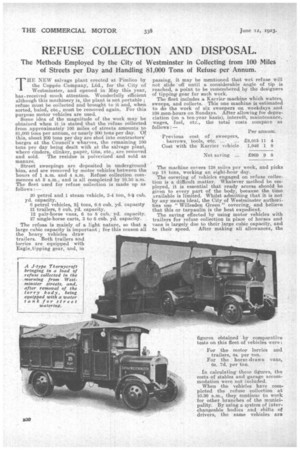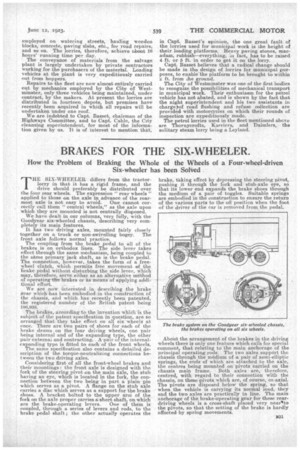REFUSE COLLECTION AND DISPOSAL.
Page 14

Page 15

If you've noticed an error in this article please click here to report it so we can fix it.
The Methods Employed by the City of Westminster in Collecting from 100 Miles of Streets per Day and Handling 81,000 Tons of Refuse per Annum.
T. HE NEW salvage plant erected at Pimlico by the Coppee Company, Ltd., for the City of Westminster, and opened in May this year, has.received much attention. Wonderfully efficient although this machinery is, the plant is not portable ; refuse must be collected and brought to it and, when sorted, baled, et., must be removed again. For this purpose motor vehicles are used. Some idea of the magnitude of the work may be obtained when it is stated that the refuse collected from approximately 100 miles of streets amounts to 81,000 tons per annum, or nearly 300 tons per day. Of this, about 200 tons per day are shot into contractors' barges at the Council's wharves, the remaining 100 tons per day being dealt with at the salvage plant, where cinders, clinker, paper, tins, etc.., are removed and sold. The residue is pulverized and sold as manure.
Street sweepings are deposited in underground bins, and are removed by motor vehicles between the 'hours of 1 a.m. and 4 a.m. Refuse collection commences at 5 a.m., and is all completed by 10.30 a.m. The fleet used for refuse collection is made up as follows :— 20 petrol and 1 steam vehicle, 3-4 ton, 8-9 cub. yd. capacity. 6 petrol vehicles, 21 tons, 6-8 cub. yd. capacity 21 trailers, 8 Cub. yd. capacity.
12 pair-horse vans, 6 to 8 cub. yd. capacity. 27 single-horse carts, 3 to 6 cub. yd. capacity. .
The refuse is mainly of a light nature, so that a i
large cubic capacity is important; for this reason all the heavy vehicles draw trailers. Both trailers and lorries are equipped with Fagle,tipping gear, and, in• passing; it may be mentioned that wet refuse will not slide -off until a considerable angle of tip is reached, a point to be remembered by the designers of tipping gear for such work.
The fleet includes a Karrier machine which waters, sweeps, and collects. This one machine, is estimated to do. the work of six sweepers on weekdays and 108 men-hours on Sundays. After allowing for depreciation on a ten-year basis), interegt, maintenance, wages, fuel, etc., the total costs compare as follows :— The machine covers 138 miles per week, and picks up 18 tons, working an eight-hour day.
The covering of vehicles engaged on refuse collection is a difficult matter. Whatever method be employed, it is essential that ready access should be given to every part of the body, because the time available is limited. Whilst admitting that it is not by any means ideal, the City of Westminster authorities use "Willesden Green" covering, and believe that this or tarpaulin is the best expedient. The saving effected by using motor vehicles with trailers for refuse collection in place of horses and vans is largely due to their large cubic capacity, and to their speed. After making all allowances, the employed on watering streets, hauling wooden blocks, concrete, paving slabs, etc., for road repairs, and so on. The lorries, therefore, achieve about 16 hours' running time per day.
The conveyance of materials from the salvage plant is largely undertaken by private contractors working for the purchasers of the material. Loading vehicles at the plant is very expeditiously carried out from hoppers. Repairs to the fleet are now almost entirely carried out by mechanics employed by the City of Westminster, only three vehicles being maintained, under contract, by the makers. At present the lorries are distributed in fourteen depots, but premises have recently been acquired in whieh all repairs will be undertaken under one roof.
We are indebted to Capt. Basset, chairman of the Highways Committee, and to Capt. Cable, the City cleansing superintendent, for most of the information given by us. It is of interest to mention that,
in Capt. Basset's opinion, the one great fault of the lorries used for municipal work is the height of their loading platforms. Heavy paving stones, macadam, rubbish—everything, in fact, has to be raised 4 ft.. or 5 ft. in order to get it on the lorry.
Capt. Basset believes that a radical change should be made in the, design of lorries for municipal purposes, to enable the platform to be brought to within S ft. from she ground.
The City of Westminster was one of the first bodies to recognize the possibilities of mechanical transport in municipal work. Their enthusiasm for the petrol vehicle has not abated, and is shown by the fact that the night superintendent and his two assistants in charge,of road flushing and refuse collection are provided with motorcycles on which their rounds of inspection are expeditiously made.
The petrol lorries used in the fleet mentioned above are Thornycrofts, Earriers, and Daimlers, the solitary steam lorry being a Leyland.






























